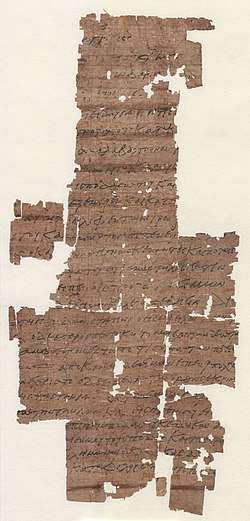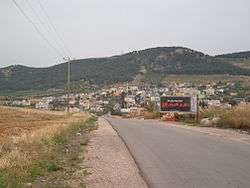Luke 7
Luke 7 is the seventh chapter of the Gospel of Luke in the New Testament of the Christian Bible. It tells the records of two great miracles performed by Jesus, his reply to John the Baptist's question, and the anointing by a sinful woman.[1] The book containing this chapter is anonymous, but early Christian tradition uniformly affirmed that Luke composed this Gospel as well as the Acts of the Apostles.[2]
| Luke 7 | |
|---|---|
_Luc_7%2C36.37.jpg) Luke 7:36,37 on Papyrus 3, written about 6th/7th century. | |
| Book | Gospel of Luke |
| Category | Gospel |
| Christian Bible part | New Testament |
| Order in the Christian part | 3 |
Text

The original text was written in Koine Greek. This chapter is divided into 50 verses.
Textual witnesses
Some early manuscripts containing the text of this chapter are:
- Papyrus 75 (AD 175-225)
- Papyrus 45 (~250).
- Codex Vaticanus (325-350)
- Codex Sinaiticus (330-360)
- Codex Bezae (~400)
- Codex Washingtonianus (~400)
- Codex Ephraemi Rescriptus (~450; lacunae: verse 17 to end)
- Papyrus 2 (~550; extant verses 22-26 and 50 in Coptic language)[3]
- Papyrus 3 (6th/7th century; extant verses 36-45)[3]
Healing the centurion's servant
Luke 7:1-10 relates that a Roman centurion in Capernaum sent the Jewish elders to ask Jesus for help because his servant (or slave) was ill.[4] The elders testified to the centurion's worthiness (ἄξιός, axios) but the centurion did not consider himself worthy (same Greek word, ηξιωσα, ēxiōsa)[5] to have Jesus come into his home to perform the healing, suggesting instead that Jesus perform the healing at a distance. Jesus concurred and the servant was found to have been healed when the centurion returned home.
A similar event is recounted in John 4:46-53 but this may refer to another event as it concerns the son of a court official.
Widow of Nain's Son Raised

This account of a miracle by Jesus is only recorded in the Gospel of Luke. Jesus arrived at the village of Nain during the burial ceremony of the son of a widow, and raised the young man from the dead. The location is the village of Nain in Galilee, two miles south of Mount Tabor. This is the first of three miracles of Jesus in the canonical gospels in which he raises the dead, the other two being the raising of Jairus' daughter and of Lazarus. Following the healing, Jesus fame spread "throughout all Judea and all the surrounding region".[6] In the Cambridge Bible for Schools and Colleges, commentator F. W. Farrar explains that "the notion that St Luke therefore supposed Nain to be in Judaea is quite groundless. He means that the story of the incident at Nain spread even into Judaea".[7]
Messengers from John the Baptist

When John the Baptist was in prison and heard of the works performed by Jesus, John sent two of his disciples as messengers to ask a question of Jesus:
- “Are you the one who is to come (ὁ ἐρχόμενος, ho erchomenos), or should we expect someone else?”[8]
Following this episode, Jesus begins to speak to the crowds about John the Baptist, describing him as the 'messenger' foretold in prophecy (Malachi 3:1).
Parable of the Two Debtors
_-_interior%2C_stained_glass%2C_A_Disciple_washes_Christ%E2%80%99s_feet.jpg)

Jesus uses the story of two debtors to explain that a woman loves him more than his host, because she has been forgiven of greater sins. This parable is told after his anointing by a "sinful woman" at the house of a Pharisee named Simon.
Verse 38
- And stood at his feet behind him weeping, and began to wash his feet with tears, and did wipe them with the hairs of her head, and kissed his feet, and anointed them with the ointment.[9]
- "Stood at his feet behind him": Jesus, as other guests, 'reclined on couches with their feet turned outwards', a common posture in that period of time also for Persians, Greeks, Romans.[10] This arrangement is called triclinia, by which the guest reposed on his elbow at the table, with his unsandaled feet outstretched on the couch (as each guest left the sandals beside the door on entering).[11]
- "Ointment": or "fragrant oil" in NKJV, is translated from the Greek word μύρον which was applied 'for any kind of sweet-smelling vegetable essence, especially that of the myrtle'.[12]
See also
- Dead Sea Scrolls 4Q521
- Miracles of Jesus
- Nain, Israel
- Other related Bible parts: Matthew 8, Matthew 11, John 4
References
- Halley, Henry H. Halley's Bible Handbook: an Abbreviated Bible Commentary. 23rd edition. Zondervan Publishing House. 1962.
- Holman Illustrated Bible Handbook. Holman Bible Publishers, Nashville, Tennessee. 2012.
- Aland, Kurt; Aland, Barbara (1995). The Text of the New Testament: An Introduction to the Critical Editions and to the Theory and Practice of Modern Textual Criticism. Erroll F. Rhodes (trans.). Grand Rapids: William B. Eerdmans Publishing Company. p. 96. ISBN 978-0-8028-4098-1.
- Translated as 'slave' in the RSV and the Holman Christian Standard Bible
- Strong's Concordance: 515 axioó: to deem worthy
- Luke 7:17
- Cambridge Bible for Schools and Colleges on Luke 7, accessed 6 June 2018
- Luke 7:19, repeated in 7:20
- Luke 7:38 KJV
- Expositor's Greek Testament. Luke 7. Accessed 24 April 2019.
- Cambridge Bible for Schools and Colleges. Luke 7. Accessed 28 April 2019.
- Exell, Joseph S.; Spence-Jones, Henry Donald Maurice (Editors). On "Luke 7". In: The Pulpit Commentary. 23 volumes. First publication: 1890. Accessed 24 April 2019.
External links
- Luke 7 King James Bible - Wikisource
- English Translation with Parallel Latin Vulgate
- Online Bible at GospelHall.org (ESV, KJV, Darby, American Standard Version, Bible in Basic English)
- Multiple bible versions at Bible Gateway (NKJV, NIV, NRSV etc.)
| Preceded by Luke 6 |
Chapters of the Bible Gospel of Luke |
Succeeded by Luke 8 |